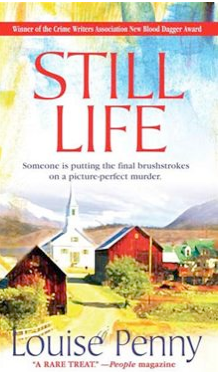DANCE REVIEW
Better curated than choreographed
BY LEWIS SEGAL
As a choreographer, Benjamin Millepied arguably brings nothing new to the Southern California dance scene beyond the scale of his ambitions. But as a curator he’s made his L.A. Dance Project a unique cultural resource with an inaugural performance dominated by the kind of daring, world-class contemporary revivals that our homegrown companies lack the will or budget to attempt.
In a three-part program at Walt Disney Concert Hall on Saturday, Millepied’s quasi-local ensemble danced the first performance anywhere of Merce Cunningham’s controversial masterwork “Winterbranch” (still photo left) since it left the Cunningham company repertory in1976. [Comment: masterwork? If you could see it or stand to listen to the extremely loud score - which followed another maddeningly repetitive and naively ageing off-key voice quavering endlessly about Jesus’ blood - ugh - I still can’t get it out of my mind.]
Abstract Expressionism at its most extreme, this1964 sextet remains oppressive in its pervasive darkness punctuated by occasional, random flashes of blinding light; in its silence shattered by a deafening, abrasive score (La Monte Young’s “2 sounds”); in its movement concept: all human activity — individual or collective — collapsing helplessly to the ground….The original production evoked the Holocaust to some observers… I do really want to see the dancers, not struggle to perceive their movements; I could only react by emotionally, aurally, and visually shutting down while this piece was performed. What about Kronos Quartet “Black Angels”? That’s tough enough for anyone’s apocolypse scenario, you think?
If this seminal act of movement theater couldn’t display L.A. Dance Project’s technical prowess, ( because no one could see it, or the costumes touted as Rauschenberg’s “design” - what, he went shopping to Target and bought exercise clothes? William Forsythe’s innovative 1993 “Quintett” certainly could and did, marred only by a sound system that reduced to mush the vital orchestral component of Gavin Bryars’ “Jesus’ Blood Never Failed Me Yet.”
Against Bryars’ evolving, deepening sonorities, Forsythe turned classical ballet inside out: warping it, twisting it, adding infusions of sports movement, ordinary (pedestrian) action, gestural accents, even shake-that-booty pop dance — but never overloading it or making the dancers into faceless instruments.
... What’s more, the logistics of dance at Disney Hall served “Quintett” brilliantly, putting the audience in the same space as the dancers and helping all the choreographic components pop out with great immediacy. I disliked the seeming inability to attempt lighting beyond placement of a few studio-type spotlights.
Millepied capitalized on that immediacy in the premiere of his “Moving Parts” to a violin, organ and clarinet score by Nico Muhly, played live above the stage. music was fresh, living corrollary to the dancing
But here, unfortunately, his very, very ordinary choreography was continually upstaged and eclipsed by the exemplary dancing and the cleverness of the staging.
Yes, it was fun to watch the dancers manipulate Christopher Wool’s portable calligraphic scenic panels, reframing the performance dynamically many different ways. Not so fun, they looked clunky and inserted - couldn’t Wool come up with anything more imaginative than just large canvasses, really now? Furthermore, they looked like dated graphic design inspired by Stephen Heller or a student project at Art Center. I liked the dancing but without toe shoes modern dance just doesn’t get the elegance or movements possible in dance, lifts almost always look clunky - can’t anyone do them? And can’t white dancers jump? Or is it just that white choreographers can’t create leaps and jumps as part of expressive movement vocabularies? Nonetheless, I saw exquisite dancers and fascinating, sometimes difficult work that deserves to be in the repertoire of a truly modern company, especially the Forsythe work, which was truly marvelous. But the choreography itself had scarcely any movement invention to recommend it, except possibly in the second art during a throwaway cluster maneuver and a more developed duet for Lugo and Nathan Makolandra.
Not wholly romantic, or competitive or out for gymnastic display, that duet was all over the map expressively — like most of the Millepied choreography that local audiences have seen — and ended with the dancers quizzically backing away as if silently asking the same question that some of us were asking: What was it that just happened ?
You might argue that L.A. Dance Project is a New York company that had an extensive international tour booked about the time its local identity was signed and sealed with Music Center funding... Perhaps it will also become Lyon Dance Project or Sadler’s Wells Dance Project in its partnerships with foreign entities... Besides the dancers mentioned, the Project personnel included Amanda Wells and Julia Eichten, plus musicians Phil O’Connor, Lisa Liu and Muhly.
 First things first: be prepared to read the most horrifying and gruesome narrative about the abduction, torture, and murder of a 2-year old child - I had to skip over this thread because it was so revolting, coming just after the Newtown shootings, and being a grandmother. The author tries to make us understand how such a dreadful event could happen. OK. I just don't enjoy reading bloody sadistic descriptions of degradation.
First things first: be prepared to read the most horrifying and gruesome narrative about the abduction, torture, and murder of a 2-year old child - I had to skip over this thread because it was so revolting, coming just after the Newtown shootings, and being a grandmother. The author tries to make us understand how such a dreadful event could happen. OK. I just don't enjoy reading bloody sadistic descriptions of degradation.










































